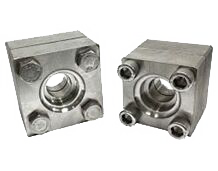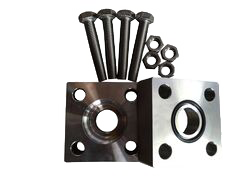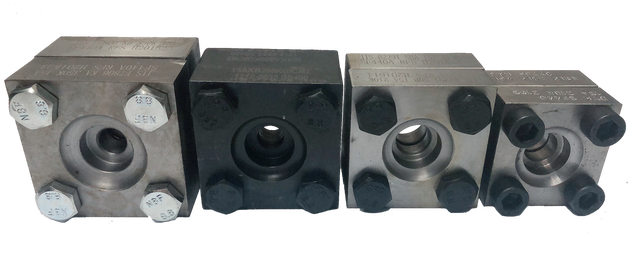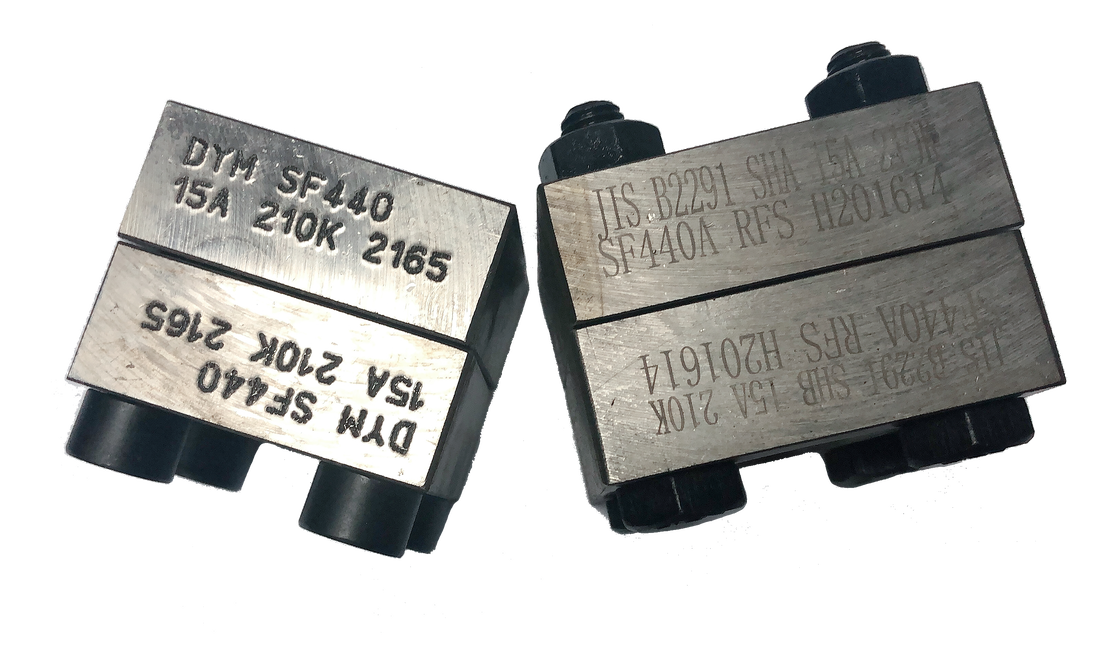Square Flanges
Square flanges are used in hydraulic systems to connect a pipe to component or a pipe to pipe connection. As the name implies, square flanges are squarely shaped. It makes in accordance to different standards based on various countries, square flanges come in different pressure rating in order to fulfill their purpose.
With square flanges, you can ensure seamless flow of liquids through stainless and steel pipes or any other hydraulic systems. Square flanges come in different sizes from 1/4 inches to 6 inches. The common sizes for system installations are 1/2 to 2 inches.
With square flanges, you can ensure seamless flow of liquids through stainless and steel pipes or any other hydraulic systems. Square flanges come in different sizes from 1/4 inches to 6 inches. The common sizes for system installations are 1/2 to 2 inches.
Size |
|
Material |
|
Working Pressure |
|
Connection Type |
|
Configuration |
|
CATALOGUE :
What are Square Flanges
1. How do you identify a square flanges?
|
Square flange can be classified as two materials which are steel or stainless steel. It is made of SF440A steel or SS316 stainless steel. They are made to fit the standards of JIS B2291 as well as JIS F7806. This means that it works well with any Japanese Industrial Standard pipes in water systems, offshore, pipe projects and oil fields. Square flanges can withstand high pressure moving connected pipes, and there are three different pressure scale: 210kg/cm², 280kg/cm² and 350kg/cm².
Among the different standards governing flange design and specifications, the JIS (Jajanese Industrial Standards) B2291 and F7806 standards are widely recognized for their quality and reliability, ensuring uniformity and compatibility across different systems. It’s also two popular choices known for their durability, strength, and versatility. Characterized by their sturdy construction and precise dimensions, JIS B2291 Square Flanges are components used in hydraulic systems to connect pipes or tubes. They are designed to withstand high pressure and ensure leak-free connections. Various sizes and pressure ratings of square flanges available to accommodate different application requirements. JIS F7806 Square Flanges are designed specifically for marine applications, providing a reliable connection in shipbuilding and offshore structures. It features robust construction to withstand the harsh conditions encountered at sea, commonly used in piping systems onboard ships, offering a secure connection for fluid transfer. Similar to JIS B2291 flanges, they adhere to stringent quality standards to ensure performance and safety in maritime environments. The performance of JIS B2291 and F7806 square flanges may vary, depending on the factors such as pressure rating, temperature range, and compatibility with different fluids. SS316 Stainless Steel is a widely used material in various industries due to its excellent corrosion resistance, high strength, and durability. It contains a higher percentage of chromium and nickel compared to SS304, making it more resistant to corrosion, mostly preferable especially in harsh environments such as marine or chemical processing. SF440A Steel is a carbon steel grade that is commonly used for flanges in piping systems. It is often used in applications where moderate strength and good ductility are required. SF440A Steel typically has a carbon content ranging from 0.04% to 0.50%, along with other alloying elements such as manganese and silicon. Square Flanges made from these materials would exhibit different characteristics and performance, depending on the specific requirements of the applications. SS316 Stainless Steel flanges would offer superior corrosion resistance. While SF440A Steel flanges, on the other hand, may be more cost-effective but would require proper corrosion protection in corrosive environments. |
2. Why square flanges are used in piping?
Square flanges serve several essential purposes in piping systems, including ensuring secure connections between pipes and equipment, providing structural support to withstand pressure and stress, facilitating easy installation and maintenance with standardized dimensions, and enhancing the overall aesthetic appeal of the system.
The square flange is highly useful in multiple high pressure industries such as connections between pipes, as well as between pipes and other components that are necessary to get a full system working. It is widely used as a category of pipe fittings. Square flange end connection is welding type and it is called socket weld or weld-in. The pipe has to insert in to the recessed area of the flange, or socketed so as to have a plain end. Other connections can be customized upon request.
The square flange can work in many different situations, but it is considered most useful when working in small diameter pipes. It is not recommended for larger diameter pipes, where there is a large weight load working within. However, square flange is not ideal to work well under high torque environment.
Square flanges serve several essential purposes in piping systems, including ensuring secure connections between pipes and equipment, providing structural support to withstand pressure and stress, facilitating easy installation and maintenance with standardized dimensions, and enhancing the overall aesthetic appeal of the system.
The square flange is highly useful in multiple high pressure industries such as connections between pipes, as well as between pipes and other components that are necessary to get a full system working. It is widely used as a category of pipe fittings. Square flange end connection is welding type and it is called socket weld or weld-in. The pipe has to insert in to the recessed area of the flange, or socketed so as to have a plain end. Other connections can be customized upon request.
The square flange can work in many different situations, but it is considered most useful when working in small diameter pipes. It is not recommended for larger diameter pipes, where there is a large weight load working within. However, square flange is not ideal to work well under high torque environment.
3. What are different types of flanges?
There are many different configurations, which are SHAB, SSAB, KAB and blind flange.
There are many different configurations, which are SHAB, SSAB, KAB and blind flange.
- SHAB is the most common used in the industry, it works in maximum pressure 210kg/cm² and it is used together with hexagon bolts.
- SSAB works under pressure 210kg/cm² too. However, the body is smaller compared to SHAB and it is used together with Allan cap screws.
- KAB with similar configuration to SHAB but having a main difference of higher pressure rating for either 280kg/cm² and 350kg/cm².
- Square Blind Flanges are used to close the end flow of the system connection.
- LSA Square Flanges represents a unique variant of the O-ring side square flanges, featuring an L shape design in its internal flow.
|
A complete set of square flange included 5 important parts. It is 1 piece of female side, label as A side, 1 piece of male side, label as B side, 4 pieces of hexagon or allen cap screws, 1 piece of NBR 70/90 oring and 4 pieces of hexagon nut (optional). Hexagon nuts are paired with hexagon bolts to use in tightening up both male and female sides.
|
4. Why square flanges are used in piping?
Shipbuilding
Square Flanges play a crucial role in connecting piping systems for fuel, water, and other fluids. To ensure a reliable fluid system, contributing to the safety and efficiency of maritime operations.
Marine Engineering
Due to the excellent corrosion-resistant properties and high-strength construction, square flanges are widely used in piping systems aboard ships, offshore platforms, and maritime installations.
Oil and Gas Industry
Square flanges are employed in upstream, midstream, and downstream operations, including drilling, refining, and transportation. Used in pipelines, refineries, and petrochemical plants to connect and control fluid flow in piping systems.
Hydraulic Systems
Being able to connect pipes, hoses, and fittings, ensuring efficient transmission of hydraulic fluid and maintaining system pressure. Widely employed in hydraulic machinery, construction equipment, and automotive applications.
Shipbuilding
Square Flanges play a crucial role in connecting piping systems for fuel, water, and other fluids. To ensure a reliable fluid system, contributing to the safety and efficiency of maritime operations.
Marine Engineering
Due to the excellent corrosion-resistant properties and high-strength construction, square flanges are widely used in piping systems aboard ships, offshore platforms, and maritime installations.
Oil and Gas Industry
Square flanges are employed in upstream, midstream, and downstream operations, including drilling, refining, and transportation. Used in pipelines, refineries, and petrochemical plants to connect and control fluid flow in piping systems.
Hydraulic Systems
Being able to connect pipes, hoses, and fittings, ensuring efficient transmission of hydraulic fluid and maintaining system pressure. Widely employed in hydraulic machinery, construction equipment, and automotive applications.
5. How are flanges attached to pipes?
Check out the 4 easy step to assemble square flanges down below:
Step 1: Make sure the surface is free from any contamination or scratch marks, then apply lubricant system fluid on each of the O-ring parts.
Check out the 4 easy step to assemble square flanges down below:
Step 1: Make sure the surface is free from any contamination or scratch marks, then apply lubricant system fluid on each of the O-ring parts.
|
Step 2: Place the flanges in the right position and fix the bolts through the bolt holes accordingly.
Step 3: Hand tighten the flanges with bolts and nuts. Step 4: Use a wrench to tighten the bolts and nuts to optimum tightness. With its unique design and distinct features, square flanges are immensely used in high pressure systems. |
CATALOGUE :





